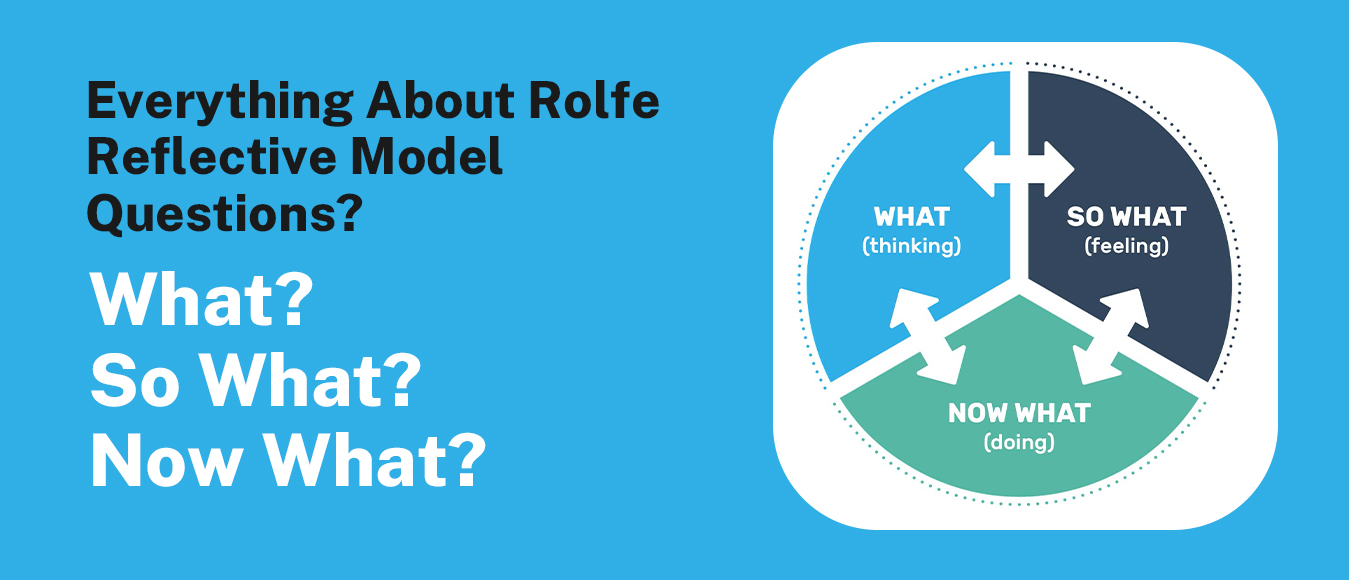Everything about Rolfe Reflective Model Questions What? So What? Now What?
The Rolfe Reflective Model is an effective structure for developing both one’s professional and personal development around reflective practice by helping people attain deeper levels of self-awareness and discoveries. This paradigm, created by Rolfe, Freshwater, and Jasper, provides an organized way to reflect by asking three fundamental questions: What? So What? Now What? With each question, you can take a step closer to comprehending your experiences, evaluating their importance, and deciding what to do next.
Therefore, in this blog post, you will learn about the core of the Rolfe Reflective Model, such as how to write a reflective essay, as well as the significance and impact of each question, and how this model may improve our reflective process.
So, let’s start this insightful examination of the What So What Now What, structure and learn about its redefining potential.
Rolfe Model of Reflection
An organized framework that aids in reflective practice is the Rolfe Model of Reflection. This model was created by Rolfe, Freshwater, and Jasper and has three key phases: What so what now what; phase entails describing the experience, along with the relevant facts and context. The So What? stage invites people to examine their feelings, ideas, and responses to the experience while also considering its relevance and significance for them.
The action- and future-oriented Now What? stage is where people decide what modifications, enhancements, or tactics to put the lessons learned from contemplation into practice. The Rolfe Model of Reflection offers an organized method to encourage acquiring knowledge, personal growth, and career growth.
Reflective Model According to Rolfe et al
The Rolfe model of reflection, as defined by Rolfe et al., is a systematic framework for encouraging reflective practice. By evaluating their experiences, emotions, and thoughts, people are encouraged to actively participate in the act of reflection by using this approach. The three key parts of the reflective model are: reporting the experience, examining the experience, and assessing the experience.
- The Rolfe et al reflective model’s first stage involves a detailed description of the experience or incident, indicating what took place, when it took place, and who was engaged.
- They examine the causes of their reactions in the second stage of the reflective cycle, analyzing what they are feeling and thinking about the event, and looking for any trends or themes.
- Finally, during the evaluation stage, people critically reflect on the event, considering its implications, what they have learned, and how they might use this information moving forward.
Using the Rolfe et al Reflective Model can help people learn new things, become more aware of themselves, and further their personal and professional development.
Reflective Model Question What, So What, Now What?
An organized method for directing the reflective process is the “What, So What, Now What” reflective paradigm. Each phase encourages the person to examine various facets of their experience and derive valuable insights from it.
What?
A detailed description of the experience or occurrence is required in the initial step of what so what now what model of reflection. It entails giving accurate details of what occurred, who was involved in it, and the circumstances surrounding it.
So What?
The person contemplates the importance and meaning of the encounter at this point of reflective cycle models. They examine their feelings, ideas, and behaviors while considering why the experience was significant to them.
Now What?
The third step concentrates on thinking about potential future actions or adjustments that can be taken in response to the reflection. It entails identifying takeaways, areas for advancement, or methods for putting fresh information or ideas to use in new contexts.
What So What Now What Reflection Example
What so what now what reflection example is as follows:
What – We had trouble communicating and coordinating during a recent group project. Deadlines were missed because of several team members’ inactive participation.
So What – I’ve learned the value of strong collaboration and communication due to this experience. It emphasized the necessity for distinct roles and duties, frequent briefings on the status of the project, and an open discussion to address problems and concerns.
Now What – I intend to be more proactive in establishing communication and setting expectations to better subsequent group initiatives. I’ll recommend routine check-ins, set up a shared task management system, and promote honest and open communication among team members. To resolve any disagreements that may develop, I will also work on improving my active listening and conflict-resolution abilities.
Problems Student Face During Reflective Model Writing
When writing reflective cycle models, learners could run into a few difficulties. Some such issues include:
Lack of Comprehension
The notion and objective of reflective cycle writing may be difficult for students to understand, which might make them unsure of how to tackle the assignment successfully.
Self-Reflection Is Challenging
Students must dive deeply into their thoughts, feelings, and experiences to be able to write reflectively. It could be difficult for certain students to reflect and express their ideas in a clear and relevant way.
Layout and Structure
The organization of their thoughts, the presentation of a logical flow across the writing, and sustaining a logical flow are all challenges that students may have when building their reflective models.
Limited Capacity for Critical Thought
The examination and critical analysis of events is necessary for producing effective reflective writing. Students could find it difficult to expand on a narrative description of events and to strengthen their ability to reason critically.
Time Management
It takes a lot of time and demands great planning and reflection to write reflectively. Students could struggle with time management, particularly if they have many assignments or short deadlines.
Writing and Language Abilities
Some pupils might struggle to adequately communicate their perspectives and opinions in writing. They could struggle to accurately communicate their reflections due to problems with syntax, vocabulary, structure of sentences, and general coherence.
Emotional Difficulties
Reliving personal memories is a common practice in reflective writing, that can be emotionally charged. It could be challenging for students to control these feelings and create a delicate equilibrium in their writing between being honest and seeming professional.
These are a few of the problems faced by students. However, they can get assistance from teachers, writing centers, or internet sites that provide advice on reflective writing strategies to address these difficulties. Periodic self-reflection practice can also be beneficial for gaining the abilities and trust needed to share one’s ideas and experiences.
Professional Essay Services for Rolfe Reflective Model
When it comes to helping students who are expected to use the Rolfe Reflective Model in their academic writing, professional custom essay writing services are a huge help. These services provide knowledgeable direction and assistance in creating well-organized, considerate essays that successfully answer the What? So What? Now What? framework.
Professional authors with subject-matter expertise can give examples and perspectives to help learners better appreciate the subtleties of Rolfe’s framework for reflective practice. They may assist with structuring concepts, enhancing arguments, and assuring the essay’s readability and consistency. With the aid of expert essay writing services, students may successfully negotiate the challenges of the Rolfe Reflective Model and produce excellent reflective essays that exhibit in-depth self-reflection and conceptualization abilities.
Conclusion
What so what now what model of reflection questions offers an effective structure for comprehending experiences in greater depth, acquiring new perspectives, and making plans for both personal and professional progress. You can increase your self-awareness, analyze the meaning of your experiences, and decide on future-oriented concrete steps by participating in this reflective process.
The What? question invites people to fully explain the event; the So What? question invites you to explore its significance and effects; and the Now What? question pushes them to think about how they may use this newfound knowledge going forward. You may open a door to ongoing learning, growth, and constructive change by integrating Rolfe’s framework for reflective practice.
However, if you’re still struggling in writing a reflective essay and need an expert for your assistance then consider opting for services like pay someone to do my essay and getting the best professional at your service.

Recent Posts
- Steps to write a reflective statement with a brief guide
- How To Structure Paragraphs Using The PEEL Method For An Essay?
- Issues With Nursing Study, Contemporary Issues For Nurses And Its Practice
- Everything about Rolfe Reflective Model Questions What? So What? Now What?
- Writing 3000 words essay and no of references should a 3000 word essay have?

